These parasites cause monetary losses to most operations that are very difficult to quantify, but we know they exist.
Cattle are restless, so they do not graze normally, which causes them to lose body condition and subsequently decrease milk production that causes losses at weaning.
Since the more common cattle parasites are blood feeders, they may transmit diseases from one herd to another.
It is important to realize the problem before performance is decreased and implement a control method.
Insecticides are commonly used to control the external parasites in cattle. There are a variety of application methods for these chemicals.
A producer decides which to use based on the level of infestation and the opportunity to apply the insecticide.
Insecticides labeled for cattle are prepared as a dust, wettable powder, emulsifiable concentrate, liquid suspension, aerosols, systemic pour-on insecticides, ear tags, stomach bolus and oral mixed with feed.
Each of these formulations has its own unique application method.
The most common external parasites that cause losses to cattle are: horn flies, stable flies, face flies, lice, ticks and several species of horse flies.
A good management program utilizing the insecticide that best fits a producer’s specific situation can control all of these parasites.
Varieties of flies
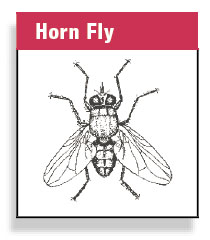
Horn flies are slightly smaller than houseflies and may cause considerable damage to cattle. They are bloodsuckers and feed on the shoulders, neck and back of cattle.
They may also feed around the horns where they attach to the skull. Horn flies remain on the cow night and day and only leave the animal to lay eggs in fresh manure.
They will move from animal to animal when they are in close proximity. Horn flies have been treated with insecticides for the past 50 years.
Many areas, especially in the South, are experiencing horn flies that are resistant to many insecticides. Resistance can be managed by utilizing a rotation between classes of insecticides.
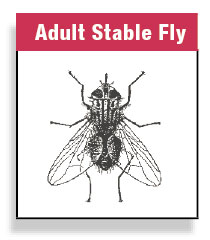
Stable flies are about the same size as a housefly and are also bloodsuckers. They will normally be found on cattle on the legs, shoulders and lower sides.
They will develop in moist, decaying vegetation such as piles of silage, bedding with straw and manure.
Keeping bedding and feeding areas free of decaying material will help control stable flies. Spraying these areas with pyrethroids will also help to control them.
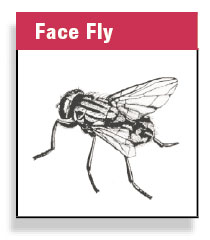
Face flies are slightly larger than the housefly and are found in almost all areas of the South where cattle are produced.
Face flies are very difficult to control because they are primarily on the head around the eyes. They have an abrasive mouth part which stimulates tear flow from the eyes.
The flies then lap up the protein-rich tears. They may also feed on nasal discharge or blood from wounds. They spend much of their time off of animals on plants or other objects in the pasture.
These flies are very annoying to cattle but also play a role in the transmission of Maraxella bovis, which is the causal agent of bovine pinkeye.
Control of face flies is best done through methods that allow self-treatment by the animal. Backrubbers with wicks or fly flips are effective, as well as dust bags placed near water or mineral feeders.
Best coverage occurs when the bag is positioned so the animal must use its head to lift it, thereby treating the face and head. Ear tags treated with insecticide are also effective at treating face flies.
Lice and ticks
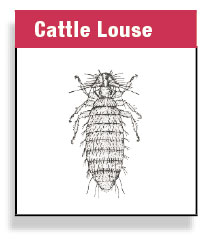
Cattle lice are found throughout the United States in several different species. Some suck blood while others cause scabs on the skin from feeding on the external skin layers.
Lice are commonly found in larger numbers in the cooler months, even winter. They cause skin irritation to the point that cattle will rub the hair off of areas, which results in bare patches of skin.
Lice are effectively controlled through systemic pour-ons, sprays and dusts.
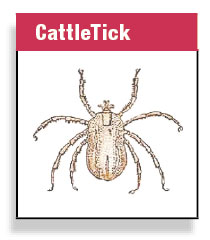
Ticks are commonly thought of as insects, but are actually arachnids. Ticks cause serious livestock losses in the southern part of the U.S., but are found in northern regions as well.
Ticks affect cattle through blood loss, reduced weight gains, transmission of diseases such as anaplasmosis and damage to fleece or hide.
Several types of insecticides are effective at treating ticks and may be labeled as acaricides. Check labels closely to make sure they are labeled for tick control.
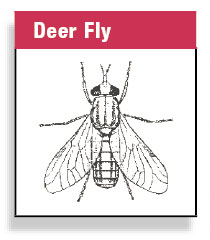
Deer and horse flies are called tabanids and are a large diverse group of blood-feeding flies. Their mouthparts are blade-like and they inflict a painful bite when feeding.
The painful bite usually draws a response from the animal that interrupts feeding, and the fly bites again.
Deer flies readily feed on humans, companion animals, livestock and wildlife, while horse flies are a serious pest of livestock but rarely attack humans.
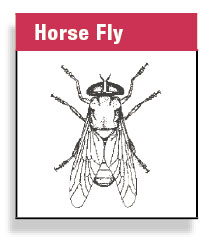
Tabanids have been reported to reduce weight gains and spread diseases. The wound from tabanids is so severe the animal will continue to bleed after the flies have fed.
Treatment options
Questions often arise as to the treatment of calves. The most common practice is to treat calves at weaning for external parasites.
There may be certain times of extremely heavy infestations when calves will have to be treated prior to weaning, but this is not common.
Anything that has the potential to prevent calves from gaining or which may increase stress should be taken seriously, and proper control measures implemented.
There are many insecticides on the market today to control external parasites on cattle.
The specific insecticide and the time of application may be region-dependent, so check with your local veterinarian and implement a solid external parasite control program.
Regular observation of cattle is the key to determining a potential problem. Watch for anything that may be interrupting a normal grazing pattern and take action if needed. ![]()
Images courtesy of Colorado State University.

Kraig Peel
Assistant Professor
Colorado State University
Kraig.Peel@colostate.edu







